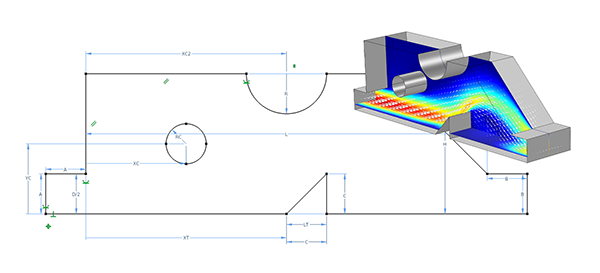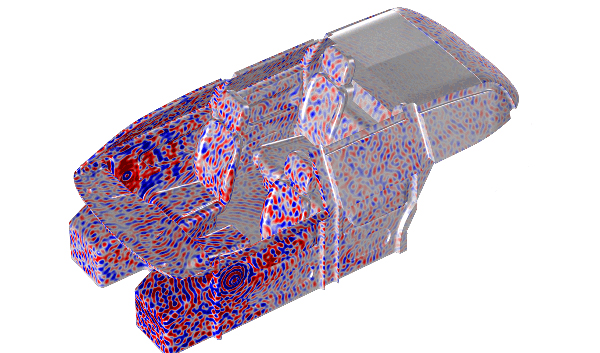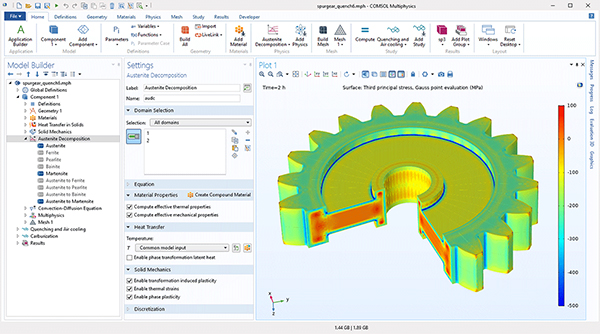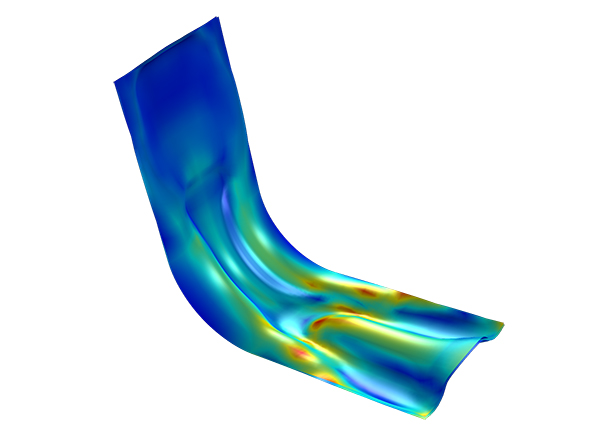Multiphysics Powerhouse Gets an Upgrade
COMSOL Multiphysics version 5.5 introduces geometry modeling tools, faster solvers and two new products: the Metal Processing Module and the Porous Media Flow Module.

Parametric optimization of fluid flow in a microvalve using the new sketching tool with dimensions and constraints capabilities available in the Design Module. Image courtesy of COMSOL.
Latest News
November 15, 2019
COMSOL, provider of software solutions for multiphysics modeling, simulation and application design and deployment, announces the latest version of its COMSOL Multiphysics software. In version 5.5, the Design Module provides a new sketching tool for easier creation and more versatile parametric control of geometry models. New and updated solvers speed up a range of simulations. Two new add-on products, the Porous Media Flow Module and the Metal Processing Module, further expand the product suite's multiphysics modeling capabilities.
Parametric Sketching with Dimensions
The Design Module provides a new sketching tool that makes it easy to assign dimensions and constraints to planar drawings for 2D models and 3D work planes. “We have carefully integrated the new dimensions and constraints tool in the Model Builder so that it becomes a natural part of the COMSOL Multiphysics workflow,” says Daniel Bertilsson, technology manager for mathematics and computer science at COMSOL. “The new tools for dimensions and constraints can be used together with model parameters in COMSOL Multiphysics to drive the simulation, whether for a single run, parametric sweep, or parametric optimization.”
Solver Technology for Acoustics Simulations
New functionality based on the time-explicit discontinuous Galerkin method enables efficient multicore computations of ultrasound propagation in solids and fluids, including realistic materials featuring damping and anisotropy. The method also has low-frequency applications, such as in seismology. The included multiphysics capabilities can seamlessly combine linear elastic wave propagation in a solid and its transition to a fluid as an acoustic pressure wave, and back again. The new elastic wave functionality is available for users of the Structural Mechanics Module, MEMS Module and Acoustics Module. The fluid-structure acoustics coupling is available in the Acoustics Module.

For frequency-domain simulations, a specialized solver for wave propagation analysis makes it possible to handle higher frequencies (shorter wavelengths) using the finite element method. The new solver can be used to analyze enclosed structures such as that of a car cabin interior as well as other acoustics simulations.
Introducing the Metal Processing Module
The new Metal Processing Module makes metal phase transformation analysis accessible within the COMSOL Multiphysics environment for applications within welding, heat treatment, and metal additive manufacturing.
“The Metal Processing Module makes it possible to predict deformations, stresses and strains resulting from wanted or unwanted heat-driven phase changes in metals,” says Mats Danielsson, technical product manager at COMSOL. “The module can be combined with any of the other COMSOL products for virtually any kind of multiphysics analysis that includes metal phase change. We envision users combining this with, for example, the Heat Transfer Module for the influence of heat radiation, the AC/DC Module for induction hardening, and the Nonlinear Structural Materials Module for highly predictive analysis of material behavior.”

Residual stresses in a spur gear after quenching, calculated using the Metal Processing Module. Image courtesy of COMSOL.
Introducing the Porous Media Flow Module
The Porous Media Flow Module gives users within, for example, pharmaceutical, and biomedical industries a wide range of transport analysis capabilities for porous media. The new add-on product includes functionality for single- and multiphase flow in porous media, drying and transport in fractures. The flow models cover linear and nonlinear flow in saturated and variably saturated media with special options for slow and fast porous media flows. The multiphysics simulation capabilities are extensive, with functionality that includes options for calculating effective thermal properties for multicomponent systems; poroelasticity; and transport of chemical species in solid, liquid and gas phases.
Simplified Shape and Topology Optimization

Users working with mechanical, acoustics, electromagnetics, heat, fluid, and chemical analysis have been able to perform shape and topology optimization in COMSOL Multiphysics for many years. The Optimization Module now offers simplified setup of shape optimization with new built-in features such as moving boundaries parameterized by polynomials and built-in support for shell thickness optimization. A new smoothing operation for topology optimization ensures higher-quality geometry outputs that can be used for additional analysis and additive manufacturing. COMSOL Multiphysics now has general support for import and export of the additive manufacturing formats PLY and 3MF, in addition to the STL format that is already available.
Nonlinear Shell Analysis, Pipe Mechanics and Random Vibration Analysis
A wide range of nonlinear analysis options are now available for shells and composite shells, including plasticity, creep, viscoplasticity, viscoelasticity, hyperelasticity and mechanical contact. The mechanical contact modeling functionality has been extended to support any combination of solids and shells, including solid-shell, solid-composite shell and membrane-shell. Depending on the type of analysis, these improvements will be available to users of the Structural Mechanics Module, Nonlinear Structural Materials Module and Composite Materials Module.

Elastic chain drive analysis in the Multibody Dynamics Module. Colors and arrows show the velocity and velocity direction, respectively, in the chain and sprockets. Image courtesy of COMSOL.
Compressible Euler Flow and Nonisothermal Large Eddy Simulations
Users of the CFD Module will get new interfaces for compressible Euler flow and nonisothermal large eddy simulations (LES). In addition, the flow interfaces for rotating machinery now support the level set and phase field methods as well as Euler–Euler and bubbly flow. The Heat Transfer Module comes with a new interface for lumped thermal systems, an equivalent circuit modeling approach for heat transfer simulations. Radiation in semitransparent (participating) media now supports multiple spectral bands, and a new open boundary formulation for convective flow reduces solution time by 30%.
Multiscale Wave and Ray Optics, Piezoelectric Shells, and More
The Ray Optics Module can now be combined with the RF Module or Wave Optics Module for simultaneous full-wave and ray tracing simulations. This enables multiscale modeling, such as analyzing a waveguide beaming into a large room, where using a full-wave simulation would be computationally prohibitive. Combining the AC/DC Module and the Composite Materials Module, users can now analyze layered materials with both dielectric and piezoelectric layers in thin structures. In the RF Module, a set of new ports for vias and transmission lines makes setup much quicker and gives more control to the user for modeling of printed circuit boards.
Efficient Distribution of Standalone Applications
COMSOL Compiler enables the ability to create standalone applications based on COMSOL Multiphysics models with specialized user interfaces that have been built with the Application Builder. Compiled applications require only COMSOL Runtime—no COMSOL Multiphysics or COMSOL Server license is required.
“Since the release of COMSOL Compiler last fall, we have seen great response from our Application Builder users with this new possibility of distributing their applications in standalone form,” says Daniel Ericsson, application product manager at COMSOL.
The latest version of COMSOL Compiler has a new compile option for generating minimum-sized files for easier distribution. When the user launches an application for the first time, where the new compile option has been used, COMSOL Runtime is downloaded and installed, if needed, from COMSOL's website. Only one instance of COMSOL Runtime is needed for applications using the same COMSOL version. COMSOL Runtime has a size of about 350 MB and an application file can be as small as a few MB.
For more information on COMSOL Multiphysics Version 5.5, click here.
For a video on new features, click here.
For a webinar specific to this software, click here.
To sign up for other webinars, click here.
For an example of how a custom app (created using COMSOL) is spreading the use of simulation, click here. This case shows how it is used for topology optimization of heat sinks, which then are manufactured using 3D printing.
See why DE’s editors selected COMSOL Multiphysics Version 5.5 as their Pick of the Week.
Sources: Press materials received from the company and additional information gleaned from the company’s website.
More COMSOL Coverage
Subscribe to our FREE magazine, FREE email newsletters or both!
Latest News
About the Author
DE’s editors contribute news and new product announcements to Digital Engineering.
Press releases may be sent to them via [email protected].
Related Topics






